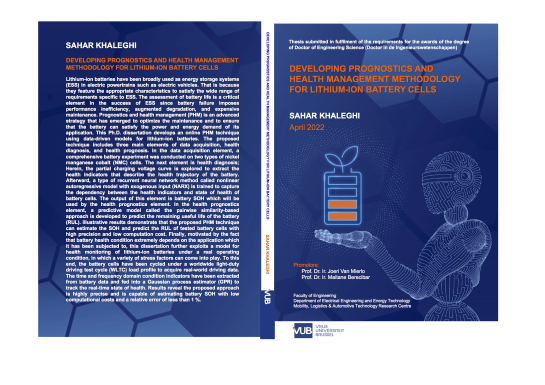
Lithium-ion batteries have been broadly used as energy storage systems (ESS) in electric powertrains such as electric vehicles. That is because they feature the appropriate characteristics to satisfy the wide range of requirements specific to ESS. The assessment of battery life is a critical element in the success of ESS since battery failure imposes performance inefficiency, augmented degradation, and expensive maintenance. Prognostics and health management (PHM) is an advanced strategy that has emerged to optimize the maintenance and to ensure that the battery can satisfy the power and energy demand of its application. This Ph.D. dissertation develops an online PHM technique using data-driven models for lithium-ion batteries. The proposed technique includes three main elements of data acquisation, health diagnosis, and health prognosis. In the data acquisition element, a comprehensive battery experiment was conducted on two types of nickel manganese cobalt (NMC) cells. The next element is health diagnosis; Herein, the partial charging voltage curve is explored to extract the health indicators that describe the health trajectory of the battery. Afterward, a type of recurrent neural network method called nonlinear autoregressive model with exogenous input (NARX) is trained to capture the dependency between the health indicators and state of health of battery cells. The output of this element is battery SOH which will be used by the health prognostics element. In the health prognostics element, a predictive model called the pairwise similarity-based approach is developed to predict the remaining useful life of the battery (RUL). Illustrative results demonstrate that the proposed PHM technique can estimate the SOH and predict the RUL of tested battery cells with high precision and low computation cost. Finally, motivated by the fact that battery health condition extremely depends on the application which it has been subjected to, this dissertation further exploits a model for health monitoring of lithium-ion batteries under a real operating condition, in which a variety of stress factors can come into play. To this end, the battery cells have been cycled under a worldwide light-duty driving test cycle (WLTC) load profile to acquire real-world driving data. The time and frequency domain condition indicators have been extracted from battery data and fed into a Gaussian process estimator (GPR) to track the real-time state of health. Results reveal the proposed approach is highly precise and is capable of estimating battery SOH with low computational costs and a relative error of less than 1%.
